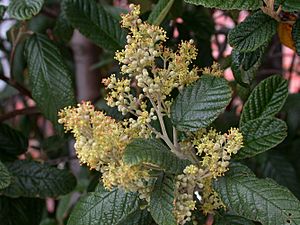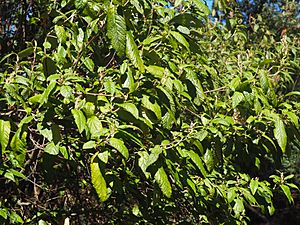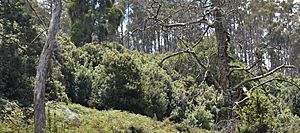Pomaderris apetala facts for kids
Quick facts for kids Pomaderris apetala |
|
|---|---|
 |
|
| Pomaderris apetala with springtime flowers, photo courtesy of Rob Wiltshire | |
| Scientific classification | |
| Genus: |
Pomaderris
|
| Species: |
apetala
|
Pomaderris apetala is a small tree or a large shrub. It belongs to the plant family Rhamnaceae. You can find it growing in Victoria, New Zealand, and Tasmania.
This plant has a few common names. In Tasmania, it's often called common dogwood or coast dogwood. In Victoria, people might call it Grampians Pomaderris or Tasman Pomaderris. In New Zealand, it's known as the New Zealand Hazel. The Māori also have names for it, like Tainui, Nonokia, and Nonorangi. The name ‘Tainui’ comes from a story about the first Māori people arriving in New Zealand. They say P. apetala plants grew from the skids of their ‘Tainui’ canoe.
Scientists have identified two main types, or subspecies, of Pomaderris apetala:
- Pomaderris apetala Labill. subsp. apetala
- Pomaderris apetala Labill. subsp. maritima
Contents
What's in a Name?
The name Pomaderris comes from two Greek words. Poma means “a lid,” and derris means “skin.” This refers to the thin skin that covers the plant's seed pods, called capsules.
The second part of the name, apetala, is also from Latin. The letter a means “without,” and petala means “petals.” So, apetala means ‘without petals’. This is a good clue about the plant's flowers!
The first person to describe Pomaderris apetala was Jacques-Julien Houtou de Labillardière in 1805. Later, in 1997, N. G. Walsh and F. Coates described the subspecies Pomaderris apetala subsp. maritima.
Plant Description
Pomaderris apetala can grow quite tall. In southern Australia, it can reach 1 to 15 meters (about 3 to 49 feet) high. In New Zealand, it usually grows up to 4 meters (about 13 feet) tall. Its branches are grayish and covered in soft, brown, star-shaped hairs. The tree has smooth, straight stems with unique bark.
Leaves and Flowers
The leaves are shaped like narrow ovals or ellipses. They have slightly jagged edges. Each leaf has a stalk and they grow one after another along the stem. The top side of the leaves is dark green with deep veins. The underside is pale grayish. This side has noticeable veins covered in fine, grayish-brown, star-shaped hairs.
The plant's flowers grow in large clusters called panicles. They are small and can be pale yellow, cream, or greenish. These flowers grow at the ends of the branches. They do not have petals. The part of the flower that holds the seeds, called the ovary, is almost completely hidden. The green leaf-like parts under the flower, called sepals, stay on the plant. The small leaf-like structures, called bracts, fall off early.
The fruits are small, three-part capsules. These capsules open up with three parts to release the seeds. Pomaderris apetala flowers in October and November. Its fruits appear from December to January.
Subspecies Differences
The two subspecies have some small differences:
- Pomaderris apetala subsp. maritima is usually a shrub, 1 to 3 meters (3 to 10 feet) tall. Its leaves are about twice as long as they are wide (25-60mm long, 15-30mm wide). The leaf tips are rounded.
- Pomaderris apetala subsp. apetala is usually a shrub or tree, 2 to 15 meters (7 to 49 feet) tall. Its leaves are generally more than twice as long as they are wide (40-110mm long, 20-30mm wide). The leaf tips are usually pointed.
Where It Lives
Both types of Pomaderris apetala grow in Tasmania and Victoria, Australia. However, only P. apetala subsp. maritima is found in New Zealand.
In Victoria, P. apetala subsp. apetala grows in the Grampians and southern highlands. P. apetala subsp. maritima is found in the Gippsland Plain and Wilsons Promontory areas. In New Zealand, P. apetala mostly grows on the North Island and the northern part of the South Island.
In Tasmania, P. apetala subsp. apetala is common across the island. P. apetala subsp. maritima is mainly found on Flinders Island and along the northern and eastern coasts.
You can often find P. apetala near streams and fern gullies. It's a common plant along riverbanks in southeastern Tasmania. P. apetala subsp. maritima has also been seen on low sand dunes and sea cliffs.
This plant is often a key part of the undergrowth in Tasmanian wet sclerophyll forests. It also grows well in wet sclerophyll forests with rich soil. P. apetala can even form the top layer of dry rainforests. These forests usually grow in gullies or on slopes that are protected from fires. You might also see P. apetala in mixed forests and rainforests that have been affected by logging or fires.
How We Use It
Pomaderris apetala is useful for several things. It's good for stabilizing soil along streams because its roots hold the soil well. The wood from P. apetala can be used for carving, making fine wooden items, and even drawing tools.
This plant also has a low flammability, meaning it doesn't catch fire easily. This makes it a good choice to plant instead of plants that burn quickly. Because it's not very flammable, P. apetala can be grown in Building Protection Zones. These are areas around homes in places prone to bushfires. They are kept clear of easily burning plants to help protect houses.
Growing Pomaderris apetala
You can grow Pomaderris apetala from fresh seeds or from cuttings taken from young, firm shoots. This plant can handle frost. It grows best in moist, acidic soil that drains well. It also prefers a shady spot.
Protecting the Plant
Pomaderris apetala subsp. maritima is considered ‘Nationally Critical’ in New Zealand. This means there are fewer than 250 mature plants left there.
In Victoria, P. apetala subsp. apetala is considered rare. This means its populations are small or found in only a few places. P. apetala subsp. maritima in Victoria is considered vulnerable. This means it's not in danger right now, but its numbers might drop soon. This is because its habitats are threatened by changes in land use.
P. apetala also grows in three plant communities in Tasmania that are currently listed as threatened. These include Eucalyptus viminalis Wet Forest, Riparian Scrub, and Notelaea-Pomaderris-Beyeria Forest (also known as dry rainforest). Protecting these areas helps protect Pomaderris apetala.
Images for kids








